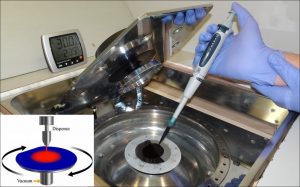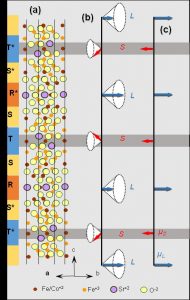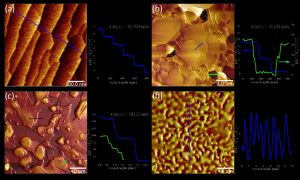Contact person: Josef Buršík
Magnetic and thermoelectric materials
Hexagonal ferrites, magnetic iron oxides, discovered in 1950s, have received much attention owing to their important properties that lend use as permanent magnets, magnetic data storage materials, as well as components in devices operating at radio frequencies (electronic components for mobile and wireless communications and low observable technology). In addition, the magnetoelectric effect discovered recently in several hexaferrites, demonstrating ferroelectricity induced by the complex internal alignment of magnetic moments, is of particular interest.
Taking into account the general trend in electronics, i.e., the search for more energy-efficient devices through the continuous miniaturization, it is expected that trends in utilization of thin films will be dominating. Therefore, the development of new thin film technologies and integration of magnetic thin-films with standard semiconductor electronics technology provides strong impetus.
The solution deposition methods (CSD) are wet chemical and multistep preparative procedures involving both chemical and physical processes enabling transformation of chemical solution of starting precursors into final solids (Fig. 1). These methods are widely used in technologies for preparation of oxide ceramics and are an attractive fabrication approach for the reasons that (i) they can be rapidly developed for the evaluation of new material systems, for system with complex chemical compositions, or material systems not previously studied in thin-film form, (ii they operate under ambient atmosphere enabling comfortable control over chemical composition and stoichiometry, (iii) they enable the film deposition on large-area substrates or on substrates with curved surfaces (contrary to methods relying on vacuum systems), and (iv) they are cost-effective, which is particularly attractive.
Our team is currently focused on the development of CSD procedures leading to well-defined thin films of hexagonal ferrites in all crystallographic structural variants (i.e., M-, X-, Y-, W-, U-, and Z-type) and to control the magnetic anisotropy needed for their practical applications (Fig. 2, Fig. 3).
Fig.1. Chemical solution deposition of thin films using spin – coating technique.
Fig.2. Schematic crystal (a) structure with marked T, S and R structural blocks and proposed magnetic structures (at small magnetic fields (b) – non-colinear magnetic order where magnetoelectric effect is observed and large magnetic fields (c) – colinear magnetic order with no magnetoelectric effect) of Z-type Sr3Co2Fe24O41 hexaferrite.
Fig.3. AFM images of surface topography of (a) bare SrTiO3(111) single crystal substrate after cleaning treatment, (b) after the 1st deposited (seed) Z-type Sr3Co2Fe24O41 layer, (c) top surface of Sr3Co2Fe24O41 thin film, and (d) MFM image taken from the same region as in (c); together with height profile scans over selected features on sample surface and calculated values of roughness (r.m.s.).
References
J. Buršík, R. Uhrecký, M. Soroka, R. Kužel, J. Prokleška, The hexaferrite Sr3Co2Fe24O41 thin films by chemical solution deposition method: Synthesis and characterization, Journal of Magnetism and Magnetic Materials 469 (2019) 245–252.
R. Uhrecký, J. Buršík, R. Kužel, et al. Use of magnetoplumbite and spinel ferrite seed layers for the growth of oriented Y ferrite thin films, Thin Solid Films 622 (2017) 104–110.
J. Hirschner, M. Maryško, K. Knížek, J. Buršík, et al. Spin Seebeck effect in Y-type hexagonal ferrite thin films, Physical Review B 96, 064428 (2017).
J. Buršík, R. Uhrecký, D. Kasčáková, et al., M-type ferrites as template layers for the growth of oriented Y-type ferrites through chemical solution deposition method, Journal of the European Ceramic Society 36 (2016) 3173–3183.
J. Buršík, M. Soroka, R. Kužel,et al., Growth and characterization of thin oriented Co3O4 (111) films obtained by decomposition of layered cobaltates NaxCoO2, Journal of Solid State Chemistry 227 (2015) 17–24.
J. Buršík, R. Kužel, K. Knížek, I. Drbohlav, Oriented Y-type hexagonal ferrite thin films prepared by chemical solution deposition, Journal of Solid State Chemistry 203 (2013) 100–105.


